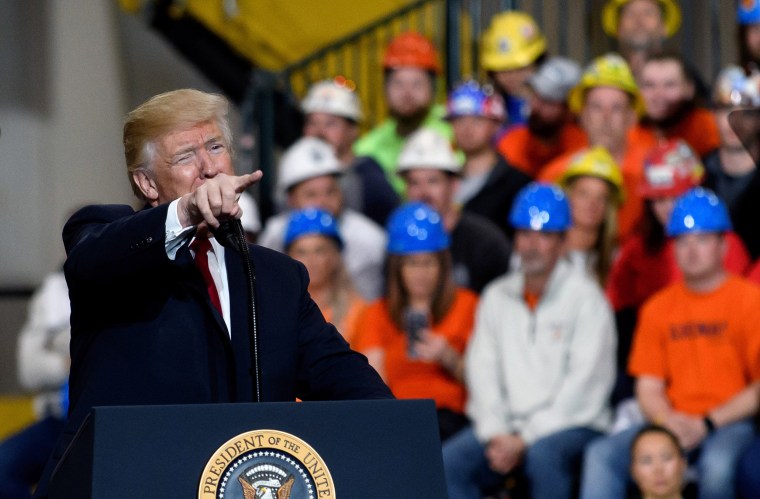President Donald Trump has been tweeting jubilantly this Tax Day. Noting that “Employment is up, Taxes are DOWN,” the president is clearly reacting to the economic anxiety that has become one of the defining characteristics of contemporary American society. Although the numbers are declining, many individuals continue to worry about their financial circumstances and stagnant wages they have experienced in recent decades. They rightfully fear for their own well-being as well as that of their children.
As a result, Trump spends a lot of his time trying to pump up voters with talk about a booming economy and rapidly decreasing unemployment. Yet the president all but ignores the biggest economic threats facing the American worker, that of accelerating innovation and major shifts in business models. In his view, the problems are lost manufacturing jobs and unfair trade, not technology disruption. And so he argues imposing new tariffs and renegotiating trade agreements will help people cope with economic stagnation.
What Trump does not understand, however, is that widespread disruption is spreading across a number of industries. Restaurant executives are reacting to tight labor markets by introducing automated tablets that transmit food orders. Rather than use the services of wait staff, customers place orders through mobile screens. In June of 2017, McDonald’s announced plans to install “digital ordering kiosks” in place of cashiers at 2,500 of its American restaurants and mobile ordering at 14,000 of its stores.
Trump spends a lot of his time trying to pump up voters with talk about a booming economy. Yet the president all but ignores the biggest economic threats facing the American worker.
In the retail sector, Amazon is replacing cashiers in its new storefront locations. Rather than employ humans to scan purchases and generate a bill, Amazon Go “allows customers [to] check in to the store using a smartphone app and walk out with what they need” while sensors track and charge them for their purchases, according to the New York Times. With retail clerks and cashiers constituting six percent of the U.S. workforce, this innovation will significantly affect overall employment.
The list of emerging technologies with the potential to reshape the workforce grows every day. As I write in my new book, “The Future of Work,” robots, autonomous vehicles, virtual reality, artificial intelligence (AI), machine learning, drones, quantum computing, and the Internet of Things are moving ahead rapidly and transforming the way businesses operate. For millions who work in food service, retail sales, and truck driving, machines are replacing their jobs. There already is evidence of this happening with blue-collar jobs, but the impact is starting to be felt by the white-collar workforce as well.
Is America up to the task of handling the transition to a digital economy? Based on available evidence, the answer is not very encouraging. It only took a 10 percent unemployment during the Great Recession and worries about undocumented immigrants to help generate the Tea Party, global populism, and, arguably, Donald Trump as president. Given the current polarization and dysfunction in the United States, the high levels of economic inequality, and deepening societal divisions, it is not clear that America’s leaders can easily resolve the social or economic anxieties associated with technology-induced disruption.
What is needed as technology accelerates is a bold agenda to protect the economic and social well-being of ordinary Americans and heal the deep divisions provoked by economic disruption. Policymakers should renegotiate the social contract and develop lifelong learning programs that help workers cope with looming shifts and develop new skills as old industries fade. Without training assistance, it will be difficult for all these people to transition to new employment.
In a political system based on geographic representation, the mismatch between prosperity and representation is a recipe for disaster.
In addition, it will be important to adopt fundamental political reforms that help leaders deal with the anger, anxiety and frustration generated by economic dislocations. Right now, the most prosperous parts of the United States constitute a small fraction of the country, while large segments experience limited prosperity. In a political system based on geographic representation, the mismatch between prosperity and representation is a recipe for disaster.
The sections of the nation experiencing poor economic growth may end up controlling the bulk of the U.S. Congress and many of the state legislatures. Couple that stagnation with fears about the changing world and exposure to people who come from different backgrounds, and those areas very well could elect leaders similar to Trump who blame immigrants, minorities and foreigners for their dismal plight and who block policy actions needed to safeguard the social safety net. In other words, unless fundamental changes are made in our governing processes, Trumpism likely will last far longer than Trump himself.
Darrell M. West is vice president of governance studies and director of the Center for Technology Innovation at the Brookings Institution and author of the Brookings book, “The Future of Work: Robots, AI, and Automation."
